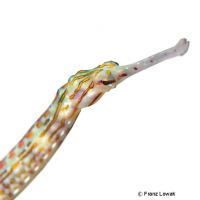Scribbled Pipefish (Corythoichthys intestinalis)
| Scribbled Pipefish Corythoichthys intestinalis | |
|---|---|
| Name | Scribbled Pipefish |
| Name Lat. | Corythoichthys intestinalis |
| Family | Pipefishes & Seahorses |
| Family lat. | Syngnathidae |
| Order | Pipefishes & Seahorses |
| Order lat. | Syngnathiformes |
| Origin | Indo-West Pacific |
| Habitat | Lagoons, coral reefs |
| Diet | Carnivore |
| pH | 8.1-8.4 |
| Hardness | 8-10 °KH |
| Behavior | Peaceful |
| Keeping | Pair, group |
| Reef Compatible | Yes |
| Care Level | Difficult |
| Life Span | 5-10 years |
| Protection | No |
| Metric Units | |
| Size | 15 cm |
| Temperature | 23-27 °C |
| Salinity | 33-36 ‰ |
| Aquarium | ~ 200 l |
| US Units | |
| Size | 6" |
| Temperature | 73-81 °F |
| Salinity | 1.020-1.025 sg |
| Aquarium | ~ 50 gal |
Distribution and habitat
The range of Corythoichthys intestinalis extends from the eastern Indian Ocean through Australia, Borneo and the Philippines to the Marshall Islands, Samoa and New Caledonia. There they live mostly in pairs or in small groups in lagoons with sandy bottoms or coral rubble between algae-covered reefs and corals up to 25 m depth.
Maintenance
They need a well structured aquarium with plenty of algae growth (Caulerpa), non-nettling corals (e.g. horn corals) and living stones that they can graze on (micro life forms) and that act like a biological filter as well as free sand areas. A weak current is ideal. Only substrates rich in lime and free of heavy metals may be used as substrate. Filters, skimmers and heaters are necessary to ensure water quality, as well as pumps to simulate tides, swells and bottom currents. Lighting must match the species-appropriate day-night rhythm of the animals
| Salinity: 33-36 ‰ | pH value: 8.1-8.4 |
| Carbonate hardness: 8-10 °KH | Nitrate content: 2-8 mg/l |
| phosphate content: 0.01-0.1 mg/l | nitrite content: 0.0-0.05 mg/l |
For salinity, an average value should be aimed for, which may only vary slightly by +/- 0.5 ‰. Ammonia and ammonium must not be measurable. Special attention must be paid to constantly good water quality.
Diet
In the wild they feed mainly on copepods, which they pick up from the bottom with their thin mouth tube. The food supply consists of live food, such as copepods and Artemia enriched with vitamins. It is recommended to change live stones more often to provide an additional food source. Sometimes they can be slowly acclimated to frozen foods (thawed), such as small mysis, bosmids, Artemia, etc. These slow feeders should be fed small portions several times a day
A regular and varied diet promotes health and increases resistance.
Behaviour and compatibility
They are very calm and peaceful animals that are best kept in pairs. Keeping multiple pairs is only recommended in a larger and richly structured aquarium. They are well suited for keeping in an invertebrate tank and should only be socialized with other small, calm and non-aggressive animals that do not compete for food. It is better to keep them in a species tank.
Sex dimorphism
In males, the brood organ, a skin sac on the underside of the caudal peduncle, can be seen
Reproduction and breeding
The spawning season can last from spring to autumn. The female transfers the eggs into the male's brood organ. After 10-14 days the small larvae hatch and are released from the abdominal pouch and brood care ends. Suitable food for rearing is phytoplankton and Artemia nauplii.
Important
These slow feeders can only take very small food, which they suck with their thin mouth tube. During feeding, the flow pump and filtration should be turned off
If different species are kept together, care should be taken to ensure that the fish match each other in terms of water quality and temperature requirements and social behavior, and that the setup meets the needs of all species kept together. New fish to be introduced must be acclimated slowly to the water in the aquarium
Further literature can be found in your pet store.
References
Text: Werner Winter; Image: Franz Lowak
Source: KUITER, DEBELIUS (2007): Atlas der Meeresfische: Die Fische an den Küsten der Weltmeere, Kosmos Verlag; PATZNER & MOOSLEITNER (1999): Meerwasser Atlas Bd. 6, Mergus Verlag; ENGELMANN (2005): Zootierhaltung - Tiere in menschlicher Obhut: Fische, Verlag Harri Deutsch
- Gemäß § 21 Abs. 5 Tierschutzgesetz idgF
